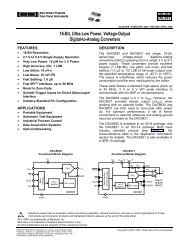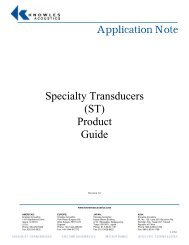AD7714* 3 V/5 V, CMOS, 500 µA Signal Conditioning ADC - dreamm
AD7714* 3 V/5 V, CMOS, 500 µA Signal Conditioning ADC - dreamm
AD7714* 3 V/5 V, CMOS, 500 µA Signal Conditioning ADC - dreamm
Create successful ePaper yourself
Turn your PDF publications into a flip-book with our unique Google optimized e-Paper software.
AD7714<br />
Data Register (RS2–RS0 = 1, 0, 1)<br />
The Data Register on the part is a read-only register which contains the most up-to-date conversion result from the AD7714. The<br />
register can be programmed to be either 16-bits or 24-bits wide, determined by the status of the WL bit of the Mode Register. If the<br />
Communications Register data sets up the part for a write operation to this register, a write operation must actually take place in<br />
order to return the part to where it is expecting a write operation to the Communications Register (the default state of the interface).<br />
However, the 16 or 24 bits of data written to the part will be ignored by the AD7714.<br />
Zero-Scale Calibration Register (RS2–RS0 = 1, 1, 0); Power On/Reset Status: 1F4000 Hex<br />
The AD7714 contains three zero-scale calibration registers, labelled Zero-Scale Calibration Register 0 to Zero Scale Calibration<br />
Register 2. The three registers are totally independent of each other such that in fully differential mode there is a zero-scale register<br />
for each of the input channels. Each of these registers is a 24-bit read/write register and, when writing to the registers, 24 bits must be<br />
written; otherwise no data will be transferred to the register. The register is used in conjunction with the associated full-scale calibration<br />
register to form a register pair. These register pairs are associated with input channel pairs as outlined in Table VII.<br />
While the part is set up to allow access to these registers over the digital interface, the part itself no longer has access to the register<br />
coefficients to correctly scale the output data. As a result, there is a possibility that after accessing the calibration registers (either read<br />
or write operation) the first output data read from the part may contain incorrect data. In addition, a read or write operation to the<br />
calibration register should not be attempted while a calibration is in progress. These eventualities can be avoided by taking either the<br />
SYNC input low or the FSYNC bit of the Mode Register high before the calibration register operation and taking them either high or<br />
low respectively after the operation is complete.<br />
Full-Scale Calibration Register (RS2–RS0 = 1, 1, 1); Power On/Reset Status: 5761AB Hex<br />
The AD7714 contains three full-scale calibration registers, labelled Full-Scale Calibration Register 0 to Full-Scale Calibration Register<br />
2. The three registers are totally independent of each other such that in fully differential mode there is a full-scale register for each<br />
of the input channels. Each of these registers is a 24-bit read/write register and, when writing to the registers, 24 bits must be written,<br />
otherwise no data will be transferred to the register. The register is used in conjunction with the associated zero-scale calibration register<br />
to form a register pair. These register pairs are associated with input channel pairs as outlined in Table VII.<br />
While the part is set up to allow access to these registers over the digital interface, the part itself no longer has access to the coefficients<br />
to correctly scale the output data. As a result, there is a possibility that after accessing the calibration registers (either read or<br />
write operation) the first output data read from the part may contain incorrect data. In addition, a read or write operation to the calibration<br />
register should not be attempted while a calibration is in progress.These eventualities can be avoided by taking either the<br />
SYNC input low or the FSYNC bit of the Mode Register high before the calibration register operation and taking them either high or<br />
low respectively after the operation is complete.<br />
CALIBRATION OPERATION<br />
The AD7714 contains a number of calibration options as outlined previously. Table XI summarizes the calibration types, the operations<br />
involved and the duration of the operations. There are two methods of determining the end of calibration. The first is to monitor<br />
when DRDY returns low at the end of the sequence. DRDY not only indicates when the sequence is complete but also that the<br />
part has a valid new sample in its data register. This valid new sample is the result of a normal conversion which follows the calibration<br />
sequence. The second method of determining when calibration is complete is to monitor the MD2, MD1 and MD0 bits of the<br />
Mode Register. When these bits return to 0, 0, 0 following a calibration command, it indicates that the calibration sequence is complete.<br />
This method does not give any indication of there being a valid new result in the data register. However, it gives an earlier<br />
indication that calibration is complete than DRDY. The time to when the Mode Bits (MD2, MD1 and MD0) return to 0, 0, 0<br />
represents the duration of the calibration. The sequence to when DRDY goes low also includes a normal conversion and a pipeline<br />
delay, t P (2000 × t CLK IN ), to correctly scale the results of this first conversion. The time for both methods is given in the table.<br />
Table XI. Calibration Operations<br />
Calibration Type MD2, MD1, MD0 Calibration Sequence Duration to Mode Bits Duration to DRDY<br />
Self Calibration 0, 0, 1 Internal ZS Cal @ Selected Gain + 6 × 1/Output Rate 9 × 1/Output Rate + t p<br />
Internal FS Cal @ Selected Gain<br />
ZS System Calibration 0, 1, 0 ZS Cal on AIN @ Selected Gain 3 × 1/Output Rate 4 × 1/Output Rate + t P<br />
FS System Calibration 0, 1, 1 FS Cal on AIN @ Selected Gain 3 × 1/Output Rate 4 × 1/Output Rate + t P<br />
System-Offset Calibration 1, 0, 0 ZS Cal on AIN @ Selected Gain + 6 × 1/Output Rate 9 × 1/Output Rate + t P<br />
Internal FS Cal @ Selected Gain<br />
Background Calibration 1, 0, 1 Internal ZS Cal @ Selected Gain + Bits Not Reset 6 × 1/Output Rate<br />
Normal Conversion<br />
ZS Self Calibration 1, 1, 0 Internal ZS Cal @ Selected Gain 3 × 1/Output Rate 6 × 1/Output Rate + t P<br />
FS Self Calibration 1, 1, 1 Internal FS Cal @ Selected Gain 3 × 1/Output Rate 6 × 1/Output Rate + t P<br />
–16–<br />
REV. B















